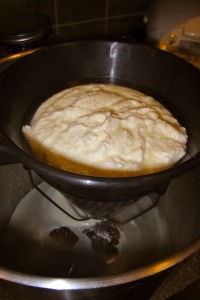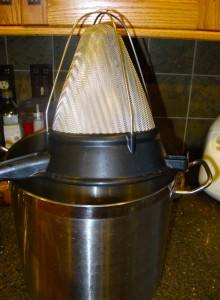A Better Way to Drain Yogurt
So, I discovered something I really didn’t like about making my own Greek yogurt.
Straining it.
Sure, it’s easy–you use multiple layers of cheesecloth to either line a strainer, or you tie the yogurt up in a bag and hang it over a bowl to catch the whey.
And that is simplicity itself.
However.
When it comes to getting the yogurt out of the cheesecloth bag and into your container, this solution becomes downright messy and irritating.
The yogurt sticks to the cheesecloth–and you have to essentially peel it off. Also, depending on the type of cheesecloth you get–it can be really essentially useless with such an open weave that even when you use four layers of it, some of the yogurt will flow out of it along with the whey and you lose lots of your valuable protein and fat.
Also, some cheesecloth sheds threads. Yeah. Threads in my yogurt. Yum.
Not.
It also sheds fibers. Fibers in my yogurt–also “not yum.”
AND, washing out the cheesecloth is another messy proposition. After you try desperately to get all of the yogurt out of it–which you will fail at, mind you–you rinse out the cloth in your sink–whereupon you will likely curse as you see all that delicious yogurt washing on down the drain when you it could instead be heading down your gullet towards your stomach. You rinse it out in the sink and then wash it in your washing machine.
But there’s a problem.
In the washing machine, if you don’t wash it by itself, it will pick up stuff from your dirty clothes.
Like lint.
Fibers.
And, my favorite and I’m sure yours–cat hair.
EUWW.
So, I resolved to figure out something to drain the yogurt more efficiently.
And I did. I use a boullion sieve.
Yes, it is an expensive piece of equipment. However, it is simple to clean (you put it in the dishwasher), it doesn’t impart hair, fibers or threads to your food and you can use it to strain anything you like. It’s actual purpose is to get every bit of particulate matter out of stock so you can make a rich, full-flavored but perfectly clear soup called boullion. So yes, you can use it for stocks.
You could use it to strain fruit and vegetable juice to get every bit of the pulp out. (Which is useful for making jelly.)
It is also an extremely sturdy piece of equipment that will likely last for decades of use, whereas most cheesecloth is doomed to fall apart after a few uses. (Unless you get the really good stuff from cheesemaking suppliers.
Before I went the route of the boullion strainer, I tried making a bag from fine muslin to drain the yogurt–but it held fibers and hair just as badly as the cheesecloth did. And picking that stuff out of yogurt is less than fun.
Edited to add: I wanted to mention the suggestions made by readers in the comments, as they are really good ideas, and are cheaper than my solution.
David T. mentioned that he uses jelly bag to strain his yogurt. The bag is made from a fine nylon mesh so there are not threads or fibers to get stuck in your yogurt. Also, you can wash it in the dishwasher.
Adam suggests that when he makes a small amount of yogurt, he strains his through a gold coffee filter. (I will say that the boullion strainer is basically like a giant gold filter–it is made of the same fine metal mesh, except in this case, it’s not gold–it’s steel.)
My main problem with either of these suggestions is that I make two quarts of yogurt at a time. The jelly bag might work for that much yogurt, but the coffee filter would require straining in several batches, and that could be frustrating.
6 Comments
RSS feed for comments on this post.
Sorry, the comment form is closed at this time.
Powered by WordPress. Graphics by Zak Kramer.
Design update by Daniel Trout.
Entries and comments feeds.





My fiancee and I use jelly bag cloth when making our own greek yogurt. Works fine, and I’ve yet to find a fiber in my breakfast, or more than a few curds of yogurt going down the drain.
Comment by David T. — August 27, 2012 #
That’s a great idea, David–and certainly cheaper than my solution.
A Jelly bag would certainly not leave fibers–it’s made of nylon! (And thus, it is SOOOOO much easier to clean.)
I never thought of using it myself….now I feel a little silly. But only a little–I do make two quarts of yogurt at a time, and I don’t know if a jelly bag would hold all of it at at a time.
Comment by Barbara — August 27, 2012 #
Copyediting nitpick: I think you want to use “bouillon,” not “bullion.”
Comment by debby — August 27, 2012 #
For small batches, I use one of the gold coffee filters. NO problems with fibers…
Comment by Adam — August 27, 2012 #
Back in days of yore…more yore than I want to count…and in college taking art classes, I had my hands in big tub loads of paper pulp making handmade paper. We could not drain the water from the tubs into the sink for fear of clogging up the pipes so we drained them into buckets lined with nylon paint strainer bags. That captured the leftover pulp which we could reuse for another project and the water was used to water the plants outside the classroom. I wonder if those bags (still have some new ones) would work to strain the yogurt. Also have fabric left over from the time we made our own silk screens. Worth trying.
Comment by Maureen — August 29, 2012 #
I bet the paint straining bags would work. If you try it and figure out that it works, let me know and I’ll add it to the list of alternatives above, Maureen!
Comment by Barbara — August 29, 2012 #